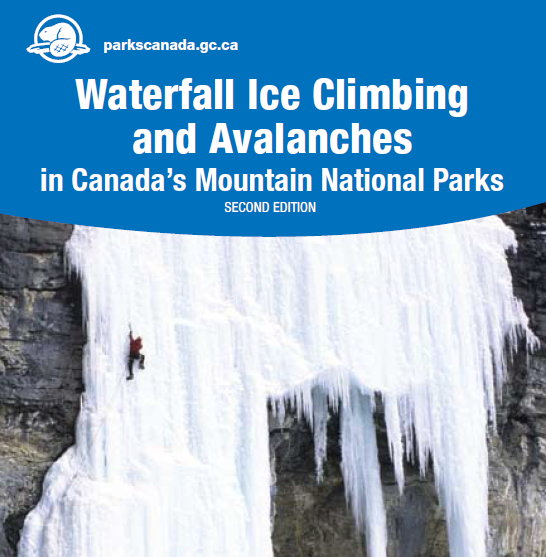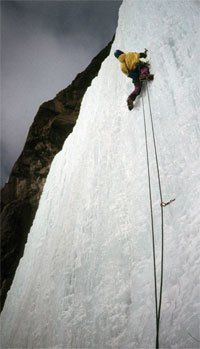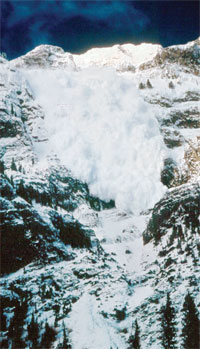Waterfall ice climbing and avalanches
Mountain safety

Simple | Challenging | Complex
Waterfall ice climbing in the national parks of Banff, Jasper, Yoho, Kootenay and Waterton Lakes offers an unparalleled experience for the ice climber. A combination of good access, reliable conditions, hundreds of options, and a long season have secured the Canadian Rockies reputation as one of the world's premier waterfall ice climbing destinations.
But winter climbing in the Canadian Rockies presents significant hazards that are unique to this area, and visitors must understand these hazards before climbing in the range. These are big mountains; climbers must be informed, prepared, aware of their options, and respectful of the conditions at all times.
Avalanche hazard
Avalanche hazard is the most significant threat to ice climbers in the Canadian Rockies. The vast majority of routes are exposed to avalanche hazard - often for extended periods. The simple fact that water flows and freezes in gullies makes ice climbing routes natural terrain traps. Some of the avalanche related challenges facing the Rockies ice climber include:
- Complicated approach terrain requiring early starts
- Long exposure times climbing waterfalls threatened by overhead hazard
- Potentially different snow and weather conditions affecting avalanche terrain above the route
- Climbing above cliffs, or between steep pitches on avalanche prone terrain
- Rapid temperature changes that trigger avalanches and topple waterfalls
- Shallow and weak snowpack conditions that prevail most of the winter
Avalanche Terrain Exposure Scale (ATES)
Traditional models used for rating avalanche danger are based on the stability of the snow, which changes regularly with the weather - from day to day, or even hour to hour. Terrain however, doesn’t change with the weather. The ATES is designed to categorize avalanche terrain based on unchanging characteristics. By using the ATES, climbers will get a sense of the type of avalanche terrain threatening their proposed route and its approach.
Avalanche Terrain Ratings and daily avalanche must be used in combination for evaluating hazards and selecting ice climbing locations.

Weeping Pillar
© Grant Statham
Avalanche bulletins
Avalanche bulletins are produced for all of the Mountain Parks, and are updated daily (twice weekly in Waterton Lakes) from November to April. Information is provided regarding the current and forecast avalanche conditions as well as danger ratings for alpine, treeline and below treeline regions. Conditions change regularly - ice climbers should check this bulletin as part of their daily routine.
Additional information is available at:
Using the ATES ratings
The following list of rated climbs represents a selection of the most popular routes in the Mountain National Parks - there are many others that are not listed here. These ratings are intended to supplement pre-trip planning material, and should be used in combination with other resources to get a good sense of your proposed climbing route. The ATES describes avalanche terrain only and does not represent the difficulty of the climbing in any way. The best resource for waterfall climbers (in 2005) is the following guidebook: Waterfall Ice, Climbs in the Canadian Rockies (fourth edition, 2002) - by Joe Josephson
This publication is widely available at local mountain specialty stores.
Click on Simple, Challenging or Complex below for a list of rated ice climbs in the Mountain National Parks.
| Description | Class | Terrain Criteria for Waterfall Ice Climbing Routes |
|---|---|---|
| Simple | 1 | Routes surrounded by low angle or primarily forested terrain; possible brief exposure time to infrequent avalanches. |
| Challenging | 2 | Routes with brief exposure to starting zones or terrain traps, or long exposure time in the runout zones of infrequent avalanches. |
| Complex | 3 | Routes with frequent exposure to multiple overlapping avalanche paths or large expanses of steep, open terrain; multiple avalanche starting zones and terrain traps or cliffs below. |
Experience and training
Ice climbing in the Rockies demands avalanche skills. Take a recreational avalanche course, carry appropriate rescue equipment, climb with solid partners, and recognize the limitations of your knowledge. If you and your partner’s understanding of avalanches is minimal, limit yourself to Simple (Class 1) terrain.
Qualified instruction and guidance can be obtained from a professional Mountain Guide who is certified by the Association of Canadian Mountain Guides, and permitted to guide in the National Parks.
General advice

Avalanche over Bourgeau-Right Hand
© Guy Chouinard
- Conditions can vary significantly from east to west across the range - eastern regions are generally drier, except following upslope storms which deposit more snow on the eastern slopes.
- Areas to the east of the National Parks offer additional options for climbs free from avalanche hazards, and a drier climate - check the guidebook.
- Avalanche bulletins cover large regions and describe the general conditions. Local variation is common and climbers must remain vigilant in their analysis of the immediate conditions while climbing.
- Temperature inversions, rain and sun exposure can rapidly change conditions and trigger avalanches - snow loses strength as its warms.
- Predicting the stability of free hanging ice is dubious. A rule of thumb is that large temperature changes within a short time frame will stress the ice and cause collapse.
- Climbing below other parties can be dangerous - consider your exposure to falling ice.
- Alpine waterfall routes (eg. Slipstream, Gimme Shelter) present additional hazards of crevasses, cornices and seracs, and may only be considered reasonable objectives during very short windows.
- “Fixation” on specific routes can lead to trouble - be open minded, well researched with options, and willing to retreat to try again another day.
- Please respect other park users in popular locations such as Johnston and Maligne Canyons. Keep the snow surface clean and pack out all litter.
Disclaimer
There are inherent risks in ice climbing, and most of the climbs described here will at times be unsafe due to potential snow avalanches. The Parks Canada Agency has done its best to provide accurate information and to describe the avalanche terrain characteristics typical of each climb. However, it is up to the users of this information to learn the necessary skills for ice climbing, access additional trip planning materials, and to exercise caution while travelling in the backcountry of any national park.
Users of this information do so entirely at their own risk, and the Parks Canada Agency disclaims any liability for injury, injury resulting in death or damage to anyone undertaking to climb any of the routes described. This information is no substitute for experience and good judgement.
Related links
- Date modified :